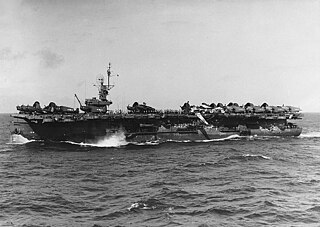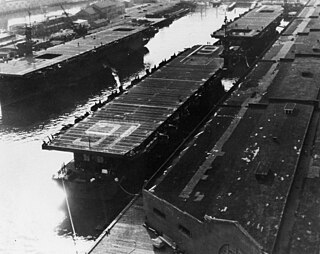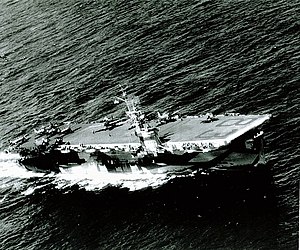
USS Admiralty Islands (CVE-99) was the forty-fifth of fifty Casablanca-class escort carrier built for the United States Navy during World War II. She was named after the Admiralty Islands campaign, a series of battles against isolated Japanese forces throughout the Admiralty Islands in the Bismarck Archipelago. The ship was launched in May 1944, commissioned in June, and served as a replenishment carrier, under the command of Capt. Edward Hastings Eldredge, in support of the invasion of Iwo Jima and the Battle of Okinawa. Postwar, she participated in Operation Magic Carpet. She was decommissioned in November 1946, when she was mothballed in the Pacific Reserve Fleet. Ultimately, she was sold for scrapping in January 1947.

USS Attu (CVE-102) was a Casablanca-class escort carrier of the United States Navy. She was named after the Battle of Attu in the Aleutian Islands and was built for service during World War II. Launched in May 1944, and commissioned in June, she served as a transport carrier, ferrying aircraft, and as a replenishment carrier, supporting the Invasion of Iwo Jima and the Battle of Okinawa. Postwar, she participated in Operation Magic Carpet. She was decommissioned in June 1946, and sold for scrapping in January 1947. After a failed acquisition attempt by the Jewish Agency, she was ultimately scrapped in 1949.

USS Bougainville (CVE-100) was the forty-sixth of fifty Casablanca-class escort carrier built for the United States Navy during World War II. She was named after the Bougainville campaign, a prolonged action against Japanese forces entrenched in the island of Bougainville off Papua New Guinea. The ship was launched in May 1944, and commissioned in June, and served as a replenishment carrier in support of the invasion of Iwo Jima and the Battle of Okinawa. She was decommissioned in November 1946, when she was mothballed in the Pacific Reserve Fleet. Ultimately, she was sold for scrapping in August 1960.

USS Lunga Point (CVE-94), originally named Alazon Bay, was a Casablanca-class escort carrier of the United States Navy. It was named for Lunga Point on the northern coast of Guadalcanal, the site of a naval battle during World War II. The ship notably participated in support of the landings on Iwo Jima and Okinawa. Post war, the ship was decommissioned in 1946, before becoming part of the Pacific Reserve Fleet. In 1960, the ship was struck from the Navy list and broken up.

USS Bismarck Sea (CVE-95) was the fortieth of fifty Casablanca-class escort carriers built to serve the United States Navy during World War II; she was the only ship of the United States Navy to be named for the Battle of the Bismarck Sea. Completed in May 1944, she served in support of the Philippines campaign, and the landings on Iwo Jima. On 21 February 1945, she sank off of Iwo Jima due to two Japanese kamikaze attacks, killing 318 crewmen. Notably, she was the last aircraft carrier in U.S. service to sink due to enemy action.

USS Hollandia (CVE-97) was a Casablanca-class escort carrier of the United States Navy. She was named after the Battle of Hollandia, a successful amphibious operation during the New Guinea campaign. Launched in April 1944, and commissioned in June, she served in support of the Battle of Okinawa. Postwar, she participated in Operation Magic Carpet. She was decommissioned in January 1947, when she was mothballed in the Pacific Reserve Fleet. Ultimately, she was sold for scrap in December 1960.

USS Makin Island (CVE-93) was a Casablanca-class escort carrier of the United States Navy. It was named for the 1942 Makin raid, an early diversionary raid designed to distract from the Guadalcanal campaign and the Tulagi campaign. Launched in April 1944, and commissioned in May, she served in support of the Philippines campaign, the Invasion of Iwo Jima, and the Battle of Okinawa. Postwar, she participated in Operation Magic Carpet. She was decommissioned in April 1946, and ultimately sold for scrapping in January 1947.

USS Makassar Strait (CVE-91) was a Casablanca-class escort carrier of the United States Navy. She was named after the Battle of Makassar Strait, an early naval engagement to the east of Borneo. Launched in March 1944, and commissioned in April, she served in support of the Battle of Okinawa. Postwar, she participated in Operation Magic Carpet. She was decommissioned in August 1946, when she was mothballed in the Pacific Reserve Fleet. Ultimately, she was used as a target, and she was accidentally run aground on San Nicolas Island in April 1961. Her wreckage survived until at least 1965.

USS Windham Bay (CVE-92) was the thirty-eighth of fifty Casablanca-class escort carriers built for the United States Navy during World War II. She was named after Windham Bay, within Tongass National Forest, of the Territory of Alaska. The ship was launched in March 1944, commissioned in May, and served as a replenishment and transport carrier throughout the Invasion of Iwo Jima and the Battle of Okinawa. Postwar, she participated in Operation Magic Carpet, repatriating U.S. servicemen from throughout the Pacific. She was decommissioned in August 1946, when she was mothballed in the Pacific Reserve Fleet. With the outbreak of the Korean War, however, she was called back to service, continuing to serve as a transport and utility carrier until 1959, when she was once again decommissioned. Ultimately, she was broken up in February 1961.

USS Kadashan Bay (CVE-76) was a Casablanca-class escort carrier of the United States Navy. It was named after Kadashan Bay, located within Chichagof Island. The bay in turn was named after Paul K. Kadashan, an Alaskan Indian who established a homestead incorporating the bay in 1915. Launched in December 1943, and commissioned in January 1944, she served in support of the Mariana and Palau Islands campaign, the Battle off Samar, and the Invasion of Lingayen Gulf. Postwar, she participated in Operation Magic Carpet. She was decommissioned in June 1946, when she was mothballed in the Atlantic Reserve Fleet. Ultimately, she was sold for scrapping in February 1960.

USS Rudyerd Bay (CVE-81) was the twenty-seventh of fifty Casablanca-class escort carriers built for the United States Navy during World War II. She was named after Rudyerd Bay, within Ketcchikan Gateway Bourough, of the Territory of Alaska. Today, the bay lies within Misty Fjords National Monument. The ship was launched in January 1944, commissioned in February, and served as a replenishment and transport carrier throughout the Mariana and Palau Islands campaign and the Philippines campaign. Later, she served as a frontline carrier, providing air cover and support for the invasion of Iwo Jima, and the Battle of Okinawa. Postwar, she participated in Operation Magic Carpet, repatriating U.S. servicemen from throughout the Pacific. She was decommissioned in June 1946, when she was mothballed in the Atlantic Reserve Fleet. Ultimately, she was sold for scrapping in January 1960.

USS Marcus Island (CVE-77) was the twenty-third of fifty Casablanca-class escort carriers built for the United States Navy during World War II. She was named after an engagement on 31 August 1943 over Minami-Tori-shima, known on American maps as Marcus Island. She was launched in December 1943, commissioned in January 1944, and she served in the Mariana and Palau Islands campaign, the Philippines campaign, as well as the Battle of Okinawa. She spent the majority of her World War II as a flagship for various escort carrier formations, serving as the headquarters for Rear Admiral William D. Sample and Felix Stump. During the Philippines campaign, she participated in the Battle off Samar, the largest naval engagement in history, and during the Battle of Mindoro, she had multiple near-brushes with Japanese kamikazes. Post-war, she participated in Operation Magic Carpet, repatriating U.S. servicemen from throughout the Pacific. She was decommissioned in December 1946, being mothballed in the Atlantic Reserve Fleet. Ultimately, she was broken up in 1960.

USS Ommaney Bay (CVE–79) was a Casablanca-class escort carrier of the United States Navy, which served during World War II. It was named after Ommaney Bay, located at the south end of Baranof Island, Alaska. Launched in late 1943 and commissioned in early 1944, the ship took part in the Mariana and Palau Islands campaign followed by several battles during the Philippines campaign in 1944 and early 1945. She was heavily damaged in a kamikaze attack and subsequently scuttled on 4 January 1945, with the loss of 95 men, including two men on board the destroyer escort Eichenberger who were killed by flying debris. She earned 2 battle stars whilst in service. In 2023, the Navy History and Heritage command announced that the wreck was located by "a combination of underwater survey and video information provided by Sea Scan Survey and DPT Scuba, two Australian diving firms, to positively identify the wreck."

USS Petrof Bay (CVE-80) was the twenty-sixth of fifty Casablanca-class escort carriers built for the United States Navy during World War II. She was named after Petrof Bay, which in turn was named in 1928 after Ivan Petroff, a Russian Alaskan who served as a special census agent for the 1880 United States census. The bay is located within Kuiu Island, which at the time was a part of the Territory of Alaska. The ship was launched in January 1944, commissioned in February, and served in support of the Mariana and Palau Islands campaign, the Philippines campaign, including the Battle off Samar, the Battle of Iwo Jima, and the Battle of Okinawa. She was decommissioned in July 1946, when she was mothballed in the Atlantic Reserve Fleet. Postwar, she participated in Operation Magic Carpet. Ultimately, she was broken up in September 1959.

USS Steamer Bay (CVE-87) was a Casablanca-class escort carrier of the United States Navy. She was named after Steamer Bay, located within Etolin Island, Alaska. Launched in February 1944, and commissioned in April, she served in support of the Invasion of Lingayen Gulf, the Invasion of Iwo Jima, and the Battle of Okinawa. Postwar, she participated in Operation Magic Carpet. She was decommissioned in January 1947, when she was mothballed in the Pacific Reserve Fleet. Ultimately, she was sold for scrapping in August 1959.

USS Sitkoh Bay (CVE-86) was the thirty-second of fifty Casablanca-class escort carriers built for the United States Navy during World War II. She was named after Sitkoh Bay, located within Chichagof Island, of the Territory of Alaska. The ship was launched in February 1944, commissioned in March, and served as a replenishment and transport carrier throughout the Philippines campaign, the Invasion of Iwo Jima and the Battle of Okinawa. She was decommissioned in November 1946, when she was mothballed in the Atlantic Reserve Fleet. With the outbreak of the Korean War, however, she was called back to service, continuing to serve as a transport and utility carrier with the Military Sealift Command until 1954, when she was once again decommissioned, and mothballed in the Pacific Reserve Fleet. Ultimately, she was broken up in January 1961.

USS Shamrock Bay (CVE-84) was the thirtieth of fifty Casablanca-class escort carriers built for the United States Navy during World War II. She was named after Shamrock Bay, located within Baranof Island, of the Territory of Alaska. The ship was launched in February 1944, commissioned in March, and served in support of the Invasion of Lingayen Gulf, the Invasion of Iwo Jima and the Battle of Okinawa. Postwar, she participated in Operation Magic Carpet. She was decommissioned in July 1946, when she was mothballed in the Atlantic Reserve Fleet. Ultimately, she was broken up in November 1959.

USS Shipley Bay (CVE-85) was a Casablanca-class escort carrier of the United States Navy. She was named after Shipley Bay, located within Kosciusko Island. The bay in turn was named after Ensign John H. Shipley, an officer on the ship surveying the Alexander Archipelago. Launched in February 1944, and commissioned in March 1944, she served in support of the Battle of Okinawa. Postwar, she participated in Operation Magic Carpet. She was decommissioned in June 1946, when she was mothballed in the Atlantic Reserve Fleet. Ultimately, she was sold for scrapping in October 1959.

USS Saginaw Bay (CVE-82) was a Casablanca-class escort carrier of the United States Navy. It was named after Saginaw Bay, located within Kuiu Island. The bay was in turn named after USS Saginaw, a U.S. Navy sloop-of-war that spent 1868 and 1869 charting and exploring the Alaskan coast. Launched in January 1944, and commissioned in March, she served in support of the Mariana and Palau Islands campaign, the Philippines campaign, the Invasion of Iwo Jima, and the Battle of Okinawa. Postwar, she participated in Operation Magic Carpet. She was decommissioned in April 1946, when she was mothballed in the Atlantic Reserve Fleet. Ultimately, she was sold for scrapping in November 1959.

USS Savo Island (CVE-78) was the twenty-fourth of fifty Casablanca-class escort carriers built for the United States Navy during World War II. She was named to memorialize the U.S. casualties of the Battle of Savo Island, which was fought as part of the Guadalcanal campaign. The ship was launched in December 1943, commissioned in February 1944, and served as a frontline carrier throughout the Mariana and Palau Islands campaign and the Philippines campaign. During the Battle of Okinawa, she provided air cover for the replenishment carrier fleet. Postwar, she participated in Operation Magic Carpet, repatriating U.S. servicemen from throughout the Pacific. She was decommissioned in December 1946, when she was mothballed in the Atlantic Reserve Fleet. Ultimately, she was sold for scrapping in February 1960.























